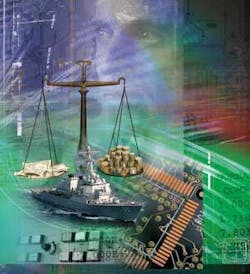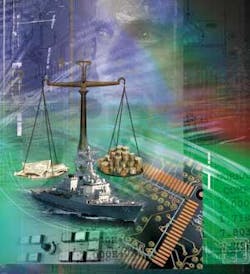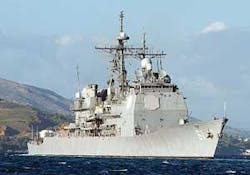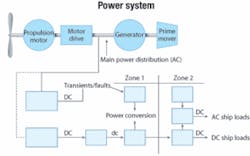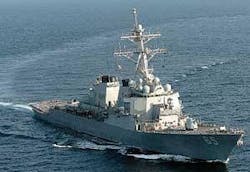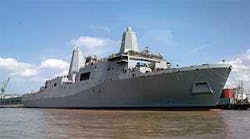Transformational plans for the seagoing service call for vast levels of wired and wireless networking of ships, submarines, aircraft, weapons, communications systems, RF antennas, and more, to offset planned cutbacks in new platform development.
By Ed Walsh
The U.S. Navy, facing severe shortfalls in its shipbuilding accounts, pressed ahead in 2004 to find innovative technology solutions to add new capability to the fleet. Cuts in research, development, and acquisition budgets for fiscal 2006, which begins Oct. 1, are expected to be even deeper than in recent years. These anticipated cuts would drive the Navy’s laboratories and its industry partners to find systems upgrades through smarter, cheaper systems engineering instead of buying new systems.
The new shipbuilding plan calls for nine San Antonio-class (LPD-17) amphibious assault ships instead of 12, and as few as seven DD(X) multimission destroyers, instead of 24, now in development by an industry team led by Northrop Grumman Ship Systems in Pascagoula, Miss. Start of construction of the first DD(X) will slip from this year to 2007.
While facing tough cuts in shipbuilding, Chief of Naval Operations Adm. Vern Clark continues to push the Navy’s “transformational” vision to meet 21st century challenges, ranging from the global war on terror, to supporting Marine operations ashore, to missile defense. Clark’s 2005 guidance calls for continuing focus on implementing his Naval Power 21 strategy, published in 2001, by strengthening the warfighting pillars of Sea Strike, Sea Shield, Sea Basing, and FORCEnet, reshaping business practices through his “Sea Enterprise,” initiative and transforming manpower policies to shape the force for new missions.
Transformation for the surface-warfare community means pushing forward on the current Open Architecture initiative, run by the Navy’s program executive office for integrated warfare systems (PEO IWS), to shift the current fleet and new-build programs to a common combat system architecture, based on an open-architecture computing environment (OACE) that eliminates the incompatibilities of the multiple dissimilar systems now fielded aboard surface combatants, amphibs, and big-deck aircraft carriers.
Rear Adm. Tom Bush, PEO IWS said last spring that Navy-industry collaboration on OA represents the “cross vision of true systems engineering.” The OA calls for a standards-based computing environment, adapting the Posix software operating system interface, the Common Object Request Broker Architecture (CORBA) of the Object Management Group, and other accepted commercial software and hardware standards.
The effort then identifies common functions like track management and combat identification that all systems must perform, as well as platform-unique functions like missile defense that will not fit the common architecture. The Navy says that the OACE will consist of the common core functions with interfaces to mission-unique applications for all surface combatants, carriers, and amphibs, extending eventually also submarines and aircraft.
The OA effort, Navy officials hope, will be complete by 2010 through four evolutionary “categories” that will encompass all future combat-systems modifications and upgrades. Categories 1 and 2, scheduled to be complete this year, establish interfaces between current systems and OA-compliant upgrades. Category 3, already in progress and set to be finished by 2008, aims at full-OA compliance for selected systems. The Category 4 architecture will permit a full range of warfighting applications that are transparent or reusable across all combat systems by means of common services and rapid, affordable upgrades.
Mil-spec to COTS
The critical element of the OA effort is transition from Navy-unique, mil-spec computer hardware and software to commercially developed processors and software that can be easily and cost-effectively upgraded through periodic technology refresh cycles.
The effort aims to eliminate from the fleet the huge inventory of obsolescent UYK-43 and UYK-44 standard shipboard computers-as well as earlier “UYK” variants that run programs written in the Navy-unique CMS-2 software programming language. Over the years, Navy and industry officials point out, the complexity of the militarized code had been aggravated by limited modifications that simply added new code, rather than integrating new functionality. Combat-systems managers say that the incremental upgrade process led over years to a layering of tightly coupled “spaghetti code” that permitted unwanted, unanticipated effects throughout the system when engineers made changes.
Lockheed Martin Maritime Systems and Sensors, longtime prime contractor for the Aegis weapon system aboard Arleigh Burke-class (DDG-51) destroyers and Ticonderoga-class (CG 47) cruisers, started in the late 1990s to shift the Aegis system from the closed Navy architecture to commercial off-the-shelf (COTS) components with baseline 6, which now runs aboard Burke-class ships from hull numbers DDG 79 through DDG 90.
Orlando Carvalho, Lockheed Martin vice president for surface systems, says that the baseline 6 COTS evolution added “adjunct” processors that ported functions between the legacy UYK-43s and UYK-44s to weapon-system interfaces.
Officials of the company and the Aegis program office in PEO IWS now are awaiting certification by the Naval Surface Warfare System’s Dahlgren division of Baseline 7 phase 1, which is already installed aboard DDGs 91 through 97. The new baseline upgrades the command-and-decision (C&D) component of the Aegis weapon system by introducing COTS-based fiber-optic local-area networks, new routers and switches, and C&D software algorithms written in C++.
Baseline 7 phase 1, however, retains the older Navy-unique shared-memory engineering for the Aegis SPY-1 phased-array radar and weapons-control component, Carvalho says. Company engineers are developing baseline 7 phase 1 refresh, or 7.1R, to be introduced on DDG-103. The new baseline brings in new COTS-based interconnect router-and-switch technology from Cisco Systems Inc. in San Jose, Calif.
Baseline 7 phase 1R, formerly called Baseline 7 phase 2, also moves the Aegis system into the OACE mandated by the Open Architecture initiative. Development should be completed in 2006 to meet the DDG-103 construction schedule.
Carvalho says Lockheed Martin is developing its OA-compliant architecture in three spirals that address simultaneously the SPY-1, weapons control, and displays. Spiral 1, he says, is already complete with baseline 7 phase 1 and Spiral 2 is implemented for baseline 7 phase 1R.
The first fully OA-compliant Aegis ship will be a cruiser instead of a destroyer. The Navy’s cruiser modernization program, launched in the late 1990s but modified often because of funding constraints, will move 23 of the original class of 27 Ticonderogas to the OA architecture.
The first five baseline 1 cruisers, CGs-47 through -51, which never were fitted with the Mk 41 vertical launch system, are being decommissioned, three already are out of service. The modernization will bring the first cruiser baseline 2 ship, the USS Bunker Hill (CG-52), into full-OA compliance by 2008.
The surface Navy is basing its shift to OA on the submarine community’s acoustics rapid COTS insertion (ARCI) program, established in the late 1990s to upgrade submarine computer systems by identifying emerging COTS technologies that quickly could be qualified and installed aboard ships at scheduled intervals.
Members of the surface community are calling their program the “rapid capability insertion process” (RCIP) that defines performance specifications for components that could be adapted for computing system upgrades. Jamie Durbin, Lockheed Martin’s Aegis technical director, says that as combat systems comply with OA standards, the RCIP provides a “landing zone” for qualified commercial products, enabling more companies to support the program.
He points out that for the ARCI, Digital Systems Resources, now part of General Dynamics Advanced Information Systems, provided the COTS-based multi-purpose processors and middleware that serves as an interface between new application programs and “core” combat systems. The RCIP enables smaller firms that qualify to participate in the Aegis business. One such firm, Technology Services Corp. (TSC), in Rockville, Md., now provides microwave devices for the SPY-1D Aegis radar and systems engineering support, including testing and analysis and integration services.
Fiber-optic links
The OA initiative also addresses the Mk 2 ship self-defense system (SSDS) developed by Raytheon Integrated Defense Systems for aircraft carriers and San Antonio- and Wasp-class (LHD-1) amphibs. The SSDS links shipboard air-defense weapons and radars across a fiber-optic network. The systems interface to the network through processors referred to as LAN access units.
Because of scheduling and development problems, Raytheon provided solely for the carrier Nimitz an early SSDS Mod 0 that retains mil-spec components, including the old Raytheon UYK-based advanced combat direction system (ACDS block 1).
The company is working on a Mod 1 for the rest of the aircraft carriers, a Mod 2 for the San Antonios, and Mod 3 for the Wasps, based on the Motorola PowerPC microprocessor. The three variants provide the same performance but differ because of the ships’ varying configurations of weapons, sensors, and displays.
As development continues at Raytheon, the Navy already is pushing for SSDS technology refresh, aiming at an OA configuration, that will redesignate the system as Mods 1A, 2A, and 3A, to be followed by 1B, 2B, and 3B, and so on.
In May 2004 the Navy awarded Raytheon a contract that could be worth as much as $38.7 million for 2005 work to migrate the Mk 2 SSDS to Category 3 OACE. The company is developing two tactical shipsets of its Category 3 software, one of which will be installed at the Surface Systems Combat Center at Wallops Island, Va., and at three test beds, one of which will be set up at the Navy’s Open Architecture site at Dahlgren, Va.
In November, Raytheon selected Entrada Networks in San Diego to supply Fiber Distributed Data Interface (FDDI) adapter cards for the OA technology refresh. In late December the company won a $10 million contract to support SSDS technical data and test tech-refresh work.
Cooperative engagement
Raytheon’s Network Centric Systems group in McKinney, Texas, is prime for the cooperative engagement capability (CEC) that, when installed on surface combatants, carriers, and big-deck amphibs, consolidates the track information from a network of air-defense radars into one data picture.
The company is delivering a block 1 system, which consists of a cooperative engagement processor, high-speed data distribution system, and a phased-array antenna. The Applied Physics Laboratory of Johns Hopkins University as a stand-alone “stovepipe,” using now-obsolescent mil-spec components, developed CEC originally in the mid-1980s.
Navy officials often have said that the CEC’s linking of ship sensors provides the foundation for “network-centric warfare” for battle-group and joint-force operations. In the mid-1990s, though, the Navy went through considerable difficulty integrating CEC programs with the Aegis combat system, an experience that pushed along the Aegis move to COTS and required meticulous engineering for CEC. The company has evolved the system from the mil-spec world, replacing Motorola 167 processors with Motorola 5100-series processors for the data-distribution system and introducing the Motorola 5100 processor as the CEC processor.
In January 2003 Aegis prime Lockheed Martin worked with Raytheon to establish a team to compete for a Navy “Block 2” CEC aimed at high levels of sensor netting, which required broad use of COTS at relatively low costs.
Raytheon then acquired Solipsys Corp. of Laurel, Md., a small company that had developed COTS-based sensor-netting technology called the tactical component network (TCN) that some Navy officials consider a potential alternative to CEC. Raytheon Solipsys continues its TCN work-in November 2004 the company won an $8 million Navy contract to develop a Pacific Fleet TCN, based on earlier PACFLT demonstrations of the technology.
Meanwhile, the CEC Block 2 effort has been canceled; replacing it is an effort to develop an open-architecture “track manager” capability within the OACE.
The OA initiative also encompasses the DD(X) combat system from Lockheed Martin as an interface to the DD(X) total-ship computing environment. The company says that its DD(X) system will incorporate technology provided by its Component-Based Total Ship System-21 (COMBATSS-21) that also will provide technology for the Aegis upgrade and serve as the combat-system baseline for the LCS and the next-generation carrier, CVN-21, and as the command-and-control system for the Coast Guard’s Deepwater national security cutter. The COMBATSS-21 will be OA Category 3-compliant, based on OA-certified software standards, and will use COTS middleware between application programs and operating system code.
RF antenna designs
Design of future ships also may benefit from the Office of Naval Research’s (ONR’s) effort to develop common radio-frequency (RF) antenna arrays. The ONR advanced multifunction RF concept (AMRF-C) is developing arrays that can handle radar, communications, and electronic warfare functions, offering the opportunity to stop the proliferation of arrays aboard ships.
The “seamless” integration of RF management also is a key goal for the FORCEnet pillar of Sea Power 21. Navy officials point out that a new Burke destroyer now is fitted with about 150 different antennas, each of which handles separate RF functions. The program, supported by the Naval Research Laboratory, stood up an AMRF-C test bed, near Annapolis Md., last fall that is looking at AMRF-C functionality at frequencies from 6 to 18 GHz.
The DD(X) program plans call for using the AMRF-C electronic warfare functionality to fill a gap in the DD(X) EW requirement caused by termination in March 2002 of work by Lockheed Martin on a new shipboard EW system.
For DD(X) ship systems, Northrop Grumman’s DD(X) National Team is designing 11 engineering development models (EDMs) of systems required by the Navy. One of the first EDMs identified for the original DD-21 program is the 155 mm Advanced Gun System from the United Defense LP Armament Systems Division in Minneapolis, which will fire a mix of extended-range munitions, conceptually to ranges well beyond 100 miles, including a GPS-guided long-range land-attack projectile (LRLAP).
United Defense is the longtime builder of the Mk 45 Mod 4 deck gun for Navy surface combatants and partner with Lockheed Martin on production of the Mk 41 vertical launch system for the Aegis fleet. The company also is providing the 110-mm gun to the Lockheed Martin LCS team.
Littoral combat ship
The LCS program started with concept studies by six industry teams in September 2002 aiming at a small (2,500-ton displacement) high-speed craft that would carry out several missions: anti-surface and anti-submarine warfare, mine countermeasures, special-forces insertion; logistics support; and intelligence-surveillance-reconnaissance. Three teams carried out preliminary design work from July 2003 through February 2004.
Lockheed Martin and General Dynamics Maritime Systems are leading teams for the Flight 0 LCS design and construction following a May 2004 downselect. In December 2004 the Navy awarded Lockheed Martin a $188 million option to its detail-design and construction contract for the first Flight 0 LCS. The company is leading one of two industry teams that will participate in the LCS construction.
Under the current plan, a similar contract will be awarded to General Dynamics in December of this year for Flight 0 ship 2. Lockheed Martin, working with shipbuilders Marinette Marine and Bollinger Shipyard, as well as naval architect Gibbs & Cox, is scheduled to deliver the first ship in January 2004; General Dynamics, teamed with Austal, BAE Systems, CAE Electronics, Maritime Applied Physics Corp., Qinetiq (United Kingdom), and GD Electric Boat, will deliver ship 2 in January 2008.
General Dynamics also has assembled a core mission systems team to develop for the LCS an open, distributed network-centric computing architecture. The team is led by the company’s Advanced Information Systems business unit, includes BAE Systems, CAE USA Inc., Marine Systems, Northrop Grumman Electronic Systems, General Dynamics Armament and Technical Products, and General Dynamics Canada.
The Lockheed team’s design is for a 378-foot-long semi-planing monohull displacing 2,839 tons, capable of 45 knots and a 3,550-nautical-mile range at cruising speed. The hull design will be based on the design for the 1,000-ton Destriero, the aluminum-hulled high-speed ship built by the Italian shipbuilder Fincantieri that holds the trans-Atlantic speed record of 53 knots per hour. The General Dynamics LCS will be 417 feet long, displace 2,675 tons, reach a top speed of 46 knots, and a range of 4,300 nautical miles
The designs for both teams will include core weapons: an advanced surface/air search radar, 57-mm gun, rolling airframe missile for terminal defense, 25-mm and 0.50-caliber guns, and decoys. Ship services, including computing, power, and heating/ventilation/air conditioning, will be distributed among ship zones and integrated with the modules, allowing for introduction of new modules and upgrades.
The LCS design approach is based on a generic ship platform that will take on specialized mission modules, with heavy reliance on unmanned systems, for anti-surface, anti-submarine, and mine warfare, and offload the modules when the missions are completed.
Navy shipbuilding managers stress that the “enabler” for the LCS is the interface between the ship platform and the mission modules. The ship-modules integration effort is being led by a mission systems and ship integration team (MSSIT) made up of staff from PEO Ships, PEO, C4I and PEO Littoral and Mine Warfare, which will act as co-leads for software interfaces. The Coast Guard also will participate, to ensure that the interfaces are compatible with interfaces for the Coast Guard’s Deepwater program. The Naval Air and Sea Systems Commands, which manage the surface and airborne unmanned systems, also will support the team.
The Navy’s move to modular loadouts aims at cutting acquisition and support costs, while pushing commonality for technology and greater mission effectiveness. The Virginia-class attack submarine program used a similar approach, for design and construction, was used for built both by General Dynamics Electric Boat and Northrop Grumman’s Newport News Co.
A mid-2004 study by the Naval Research Advisory Committee on “Science and Technology for Modular Design” notes that among other Navy programs, the ARCI and cruise missile submarine (SSGN) program, which is converting four Ohio-class ballistic missile submarines into cruise missile boats, are pursuing “transformational” uses of modularity for system design and construction.
Open architectures for new-build ships, as for the current fleet, based primarily on variants of the UYQ-70 VME display processor from Lockheed Martin Tactical Systems, DRS Technologies, and Barco Display Systems. The ’Q-70 originally was the processor target for the Aegis combat system COTS transition, the Aegis SQQ-89 undersea warfare system, and through the ARCI program is the baseline display processor for the Virginia-class (SSN-774) attack submarine combat system.
Lockheed Marti has licensed Japan’s Oki Electronics to build ’Q-70s for the combat system for Japan’s Kongo-class Aegis destroyers. The Australian, South Korean, and German navies also build the ’Q-70 under license for their navies.
In November 2004 the team delivered the 4,000 ’Q-70 to the Navy since Lockheed Martin won the first award in 1994. The Q-70, originally built with the Hewlett-Packard 743 processor, has been “opened” to run on the HP 744, as well as SunSparc and Intel VME and non-VME processors. The processor runs with ATM, SONET, Fibre Channel, and other commercial network designs.
Electric drive systems
The surface Navy also has been pushing innovation for ship machinery spaces. The DD(X) program continues to look at adapting an integrated electric drive (IED) propulsion and ship’s power architecture that would eliminate separate shipboard power systems. Integrated electric drive would use a high-torque electric motor to turn propellers, powered by either gas turbines or diesels, or nuclear reactors for carriers and submarines,.
The Navy in the late 1990s stood up an Integrated Power System test bed at the Naval Surface Warfare Center’s Carderock division’s Ship-Systems Engineering Station (SSES) in Philadelphia to explore IED architectures. General Atomics and DRS are providing power distribution modules, which reconfigure power among varying AC and DC frequencies, for three ship “zones,” with the third to be installed this year.
Under the DD(X) acquisition strategy, the industry team is developing the design to meet the Navy requirement. DD(X) prime Northrop Grumman is developing its own IED architecture, teaming with DRS Power Technology for a permanent-magnet electric motor and a power-distribution system.
For DD(X), the Philadelphia SSES signed a work for private parties (WPP) agreement to assemble by spring 2005 a DD(X) land-based test site, using much of the already-completed Navy test bed. The site will include a Rolls Royce MT-30 36-megawatt gas-turbine generator and two 4-megawatt generator units, and a General Electric 4-megawatt LM 500 gas turbine. Alstom will provide an advanced induction motor. Northrop Grumman will furnish an auxiliary power unit and all AC and DC distribution equipment.
Navy and industry officials point out that while the DRS permanent magnet motor is the current target for the first DD(X), the advanced AC induction motor is the more mature technology and likely would serve as a fallback option; PEO Ships has not yet selected the motor design for DD(X).
Meanwhile, officials of the SSES and the Navy’s integrated power systems program office within the PEO also are looking at future motors based on high- and low-temperature superconductor technology. ONR awarded a contract in February 2003 to American Superconductor for development of a full-scale 36.5-megawatt AC synchronous motor that uses high-temperature superconductor technology operating at 30 degrees Kelvin, or about -405 degrees Fahrenheit. It also awarded a contract to General Atomics to build a subscale 5,000 horsepower DC homopolar motor, which uses low-temperature superconductors (4 Kelvin or about -452 degrees F).
Superconducting motors, Navy managers say, could help save as much as two-thirds in the weight of conventional propulsion motors that scale by torque. “It takes a lot of torque to turn a propeller,” says one Navy engineering manager. For a surface combatant, a two-thirds savings could cut motor size from 200 tons to 75 tons per shaft, a savings of 250 tons per ship.
The Navy is looking at integrated power architectures for the long term. ONR has awarded a contract to the Power Systems Group business unit of L3 Communications SPD Technologies group for development of a quiet motor drive, aimed at eliminating harmonics-background noise-from propulsion systems.
The drive, PSG says, will incorporate COTS components and control software, increase system efficiency, reduce weight and cost to provide could provide a decisively new design approach for new surface ships, and possibly could be mature enough for DD(X).
The drive design includes a patented step-wave and “cascading” hardware topology that generates the unique low-harmonics waveform. Reduction of harmonics permits a smoother, more efficient flow of power to the propulsion system.
ONR officials say that the quiet drive work is the step in an evolutionary effort to develop of a shipboard integrated electric power system that started with the power-electronic building blocks (PEBBs) program, initiated in 1994. The PEBBs program developed software-controlled converters, inverters, and rectifiers and other power-control devices that handle power generated by ships’ gas turbines, diesels, and nuclear reactors. In another phase of the ONR effort, DRS Technologies is developing a high-speed PEBB-based generator that will be integrated with the PSG drive and a turbine for the integrated system.
Shipboard Electronics Glossary
ACDS - the old Raytheon UYK-based advanced combat direction system
AMRF-C - advanced multifunction RF concept
ARCI - the acoustics rapid COTS insertion program
C4I - command, control, communications, computers, and intelligence
C&D - the command-and-decision component of the Aegis weapon system
CEC - cooperative engagement capability
CG 47 - the Ticonderoga class of guided missile cruisers
CG 52 - the guided missile destroyer USS Bunker Hill
CORBA - the Common Object Request Broker Architecture standard of the Object
COTS - commercial-off-the-shelf
DDG 51 - the Arleigh Burke class of guided missile destroyers
EDM - engineering development model
FDDI - Fiber Distributed Data Interface
IED - integrated electric drive
LCS - littoral combat ship
LHD 1 -the Wasp class of amphibious assault ships
LPD 17 - the San Antonio-class amphibious assault ship
LRLAP - the GPS-guided long-range land-attack projectile
MSSIT - mission systems and ship integration team
OACE - open-architecture computing environment
ONR - Office of Naval Research
PEBBs - power-electronic building blocks
PEO IWS - The U.S. Navy program executive office for integrated warfare systems Management Group
RCIP - rapid-capability insertion process
RF - radio-frequency
SSDS - the Raytheon Mk 2 ship self-defense system
SSES - Ship-Systems Engineering Station
SSGN - cruise missile submarine program
SSN-774 - the Virginia class of attack submarines
TCN - tactical component network
TSC - Technology Services Corp. in Rockville, Md.
WPP - work for private parties agreement
